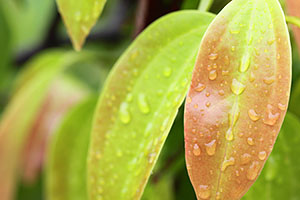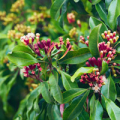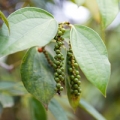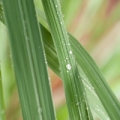Cinnamon Leaf Essential Oil
 The cinnamon tree belongs to the Lauraceae family and provides commerce with two different oils; cinnamon leaf essential oil and cinnamon bark essential oil.
The cinnamon tree belongs to the Lauraceae family and provides commerce with two different oils; cinnamon leaf essential oil and cinnamon bark essential oil.
The former oil is the type used in aromatherapy, whereas oil from the bark contains a very high concentration of cinnamic aldehyde which is a powerful skin irritant.
Therefore this particular type of cinnamon oil should not be used in aromatherapy blends for use on the skin unless you know precisely how to calculate the total levels of cinnamic aldehyde in your blend.
Known botanically as Cinnamomum verum or C. zeylanicum, cinnamon originates from the island of Sri Lanka and the neighbouring Malabar Coast of India. It is also found in Madagascar, Comoros Islands, the Tenasserim Hills of Burma, South America and the West Indies. Several attempts have been made to transplant cinnamon trees to other parts of the tropical world, but they have become naturalized only in the Seychelles.
Physical description
The cinnamon tree belongs to the Lauraceae family and is a bushy, tropical evergreen that ranges in height from 5 metres (16ft) to 15 metres (45 ft) depending on origin. The bark is rough, scaly, and highly aromatic. When stripped off and dried, this fragrant bark forms the familiar cylindrical quills that are powdered to produce what is possibly the world’s oldest and best-known spice.
The strong branches terminate in long (6-18cm), ovate or elliptic leaves that are bright green on the upper side and paler underneath, turning leathery when mature. When rubbed, the leaves emit a spicy odour and have a hot, pungent taste. The leaves are the source of the essential oil we are discussing. Young shoots are a speckled, greenish-orange colour, and from April to May in Sri Lanka small, creamy-white flowers blossom in groups.
Historical background
Cinnamon is one of the oldest aromatics which has also enjoyed an illustrious history as a spice and medicine. In the Old Testament of the Bible, (Exodus XXX, 23) the Lord spoke to Moses and gave him the formula for a holy anointing oil containing myrrh, cinnamon, cassia, calamus, and olive oil. Interestingly, this shows that the ancient Jews knew the difference between cinnamon and cassia (Cinnamomum cassia) at a time when the cheaper cassia was often passed off as true cinnamon. To this day cassia is often referred to as ‘Chinese cinnamon’.
As early as 1500 B.C. the Arabs were controlling the distribution of both types of ‘cinnamon’ to Babylon, Egypt and Rome, and were able to monopolise this lucrative trade by keeping their sources a closely guarded secret. About 1,800 years later the Romans began making expeditions across the Indian Ocean to source cinnamon and other precious commodities directly themselves, thereby revealing the secret of its origin.
In Egypt, cinnamon was used for embalming purposes, medicine and incense, whilst in medieval Europe, it was highly prized as a flavouring as well as an aromatic in religious rites. Cinnamon has an expansive range of medicinal applications that have been embraced by many cultures throughout history, including the treatment of arthritis, diarrhoea, infections, menstrual disorders, nausea, rheumatism and sore throats.
Harvesting and extraction
Apart from during the rainy season, the leaves are collected throughout the year thanks to a sustainable system of management known as coppicing. After harvesting, the leaves are removed from the branches and left to dry for a few days prior to distillation, since fresh leaves require much longer processing times.
Traditional stills in Sri Lanka are large wooden vessels capable of holding up to 200 kg of leaves, on top of which is fitted a copper still head and steam is introduced from a separate wood-fired boiler. In some cases, all-metal vessels are used and water-steam distillation is employed. Cinnamon leaf essential oil is a yellow to pale brown colour and has a warm, sweet and spicy aroma that is somewhere between a base and middle note for blending.
Aromatherapy uses
Cinnamon leaf essential oil is a powerful antiseptic, and can be used effectively to ease coughs and colds and from spreading. Put a few drops in your aromatherapy diffuser or burner to help kill airborne bacteria and also relieve the symptoms of a cold. Blend it with eucalyptus, niaouli, ravensara or tea tree essential oil for an effective bug-busting blend.
It has a warming and antispasmodic effect on the body, so in massage oils, it is excellent for easing muscular aches and pains, arthritis and rheumatism. For a powerful synergistic blend that is excellent for relieving muscular aches and sprains as well as joint pain, mix cinnamon leaf oil with Roman chamomile, sweet marjoram, or rosemary. Since cinnamon leaf essential oil can be an irritant, use it at no more than a 1% concentration on the skin.
Cinnamon oil also acts as a tonic to the mind and body, reducing drowsiness and bringing a welcome boost to flagging energy levels if you are suffering from exhaustion or burn-out. For an instant ‘pick-me-up’ blend it with ginger and lemon essential oil. Its stimulating action also makes it an effective essential oil for boosting or maintaining the immune system.
As you might expect, cinnamon essential oil blends very nicely with other spice oils such as black pepper, clove bud, cardamon and ginger, as well as bergamot, frankincense, grapefruit, lavender, lemon, orange, rosemary, tea tree, thyme and ylang ylang.
Browse Quinessence Cinnamon Leaf Essential Oil
Copyright © Quinessence Aromatherapy Ltd 2022.














